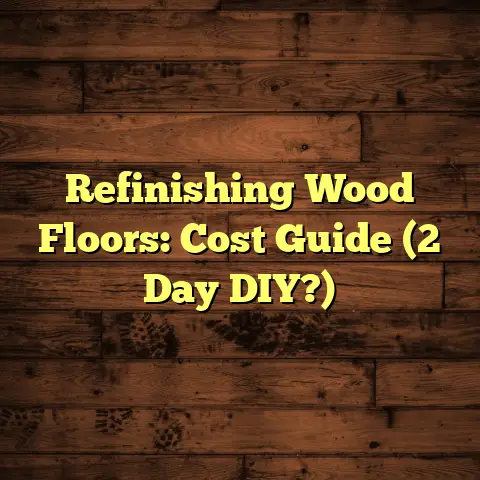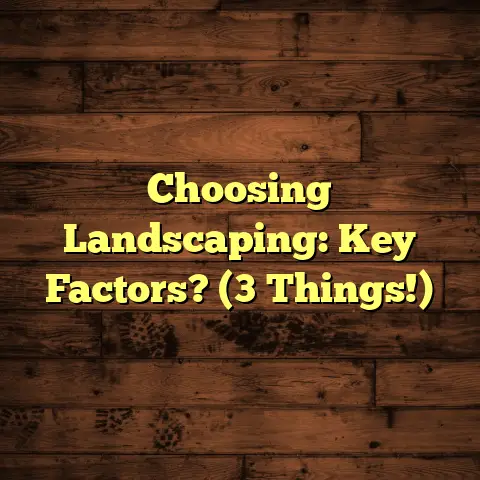Refinish Bamboo Floors? Find Out! (4 Can/Cant’s)
I get it. I’ve seen it countless times. You invested in that eco-friendly charm, that sleek, modern look.
But now? Scratches, dullness, maybe even a little water damage are stealing the show.
It’s frustrating, right? You’re picturing that initial beauty, wishing you could just rewind time. Well, maybe you can! Let’s dive into whether refinishing is the answer.
Section 1: Understanding Bamboo Flooring
1. Composition and Characteristics of Bamboo
So, what exactly is bamboo flooring?
It’s crafted from bamboo stalks, a rapidly renewable resource. That’s the eco-friendly part!
But it’s not just about being green. Bamboo is surprisingly durable, often compared to hardwoods like oak.
There are different types, though, and that matters.
-
Strand-woven bamboo: This is the toughest stuff. The bamboo strands are compressed under intense pressure. It’s super dense and resistant to scratches.
-
Horizontal bamboo: You’ll see the classic “knuckle” pattern of the bamboo stalks. It’s softer than strand-woven.
-
Vertical bamboo: The bamboo strips are oriented vertically, creating a linear look. Also generally softer than strand-woven.
The Janka hardness scale measures the resistance of a sample of wood to denting and wear. Strand-woven bamboo can reach ratings of 3000+ while horizontal and vertical bamboo often fall in the 1000-1500 range. (Source: https://www.builddirect.com/learning-center/flooring/bamboo/bamboo-flooring-hardness/)
2. Common Issues with Bamboo Floors
What are the usual suspects when it comes to bamboo floor problems?
-
Scratching: Pets, furniture, everyday foot traffic – they all take a toll.
-
Fading: Sunlight can bleach the color over time, especially if you don’t have UV protection on your windows.
-
Water damage: Bamboo isn’t waterproof. Spills need to be cleaned up ASAP to prevent warping or staining.
-
Dents: Dropping heavy objects can leave unsightly dents, especially on softer bamboo types.
Over time, these issues don’t just affect the look. They can compromise the floor’s integrity, making it more susceptible to further damage.
Section 2: The Refinishing Process
1. What Does Refinishing Entail?
Refinishing is like giving your floors a makeover. Here’s the breakdown:
-
Sanding: This is the heavy lifting. You’re removing the old finish and any imperfections, creating a smooth, even surface.
-
Staining (optional): Want a new color? This is where you apply stain to achieve your desired look.
-
Sealing: This protects the floor from scratches, spills, and everyday wear. Multiple coats are usually applied.
Tools and Materials:
- Sander: Drum sander or orbital sander, depending on the job and your experience.
- Sandpaper: Various grits, from coarse to fine.
- Stain (optional): Choose a stain specifically designed for floors.
- Sealer/Finish: Polyurethane or other durable floor finish.
- Applicators: Brushes, rollers, or pads for applying stain and finish.
- Safety gear: Dust mask, eye protection, and ear protection.
2. Can You Refinish Bamboo Floors? (The “Can’s”)
Alright, let’s get to the million-dollar question.
Can #1: Yes, You Can Refinish (Sometimes!)
The good news is, most solid bamboo floors can be refinished.
However, engineered bamboo is a different story. It has a thin layer of bamboo veneer over a core of other materials.
If that veneer is too thin, sanding will expose the core, ruining the floor.
How do you know? Check with the manufacturer or, if possible, look at a spare plank to see the thickness of the bamboo layer.
Generally, you need at least 2mm of bamboo thickness to allow for a proper sanding and refinishing.
Can #2: Restore the Luster and Extend Lifespan
Refinishing breathes new life into tired floors. It removes scratches, evens out the color, and adds a protective layer.
This not only makes your floors look fantastic, but it also protects them from future damage, extending their lifespan.
Think of it as a preventative measure, saving you money in the long run.
Can #3: Save Money Compared to Replacement
Replacing floors is a major expense. New materials, installation costs… it adds up fast.
Refinishing is significantly cheaper. You’re essentially reusing what you already have, just giving it a facelift.
I’ve seen homeowners save thousands by choosing to refinish instead of replace.
Can #4: Customize Your Look
Bored with the current color? Refinishing is your chance to change it up!
You can choose a different stain to match your evolving style.
Go darker, lighter, or even add a subtle tint. It’s like getting a brand-new floor without the brand-new floor price tag.
Section 3: The Limitations of Refinishing Bamboo Floors
Okay, it’s not all sunshine and rainbows. There are some definite “can’ts” to consider.
1. The First “Cant”: Not All Bamboo Is Refinishable
Remember that engineered bamboo we talked about?
If the bamboo veneer is too thin, sanding is a no-go. You’ll end up with an unsightly mess, exposing the core material.
Even with solid bamboo, multiple refinishings can thin the floor over time, eventually making it unsuitable for further sanding.
It’s like sanding a pencil down too far – eventually, there’s nothing left!
2. The Second “Cant”: Risk of Damage
Refinishing isn’t foolproof. There’s always a risk of damaging the floor if you’re not careful.
Improper sanding can lead to uneven surfaces, swirl marks, or even gouges.
Applying stain or finish incorrectly can result in blotchy areas or drips.
That’s why it’s crucial to take your time, use the right techniques, and maybe even practice on a small, inconspicuous area first.
3. The Third “Cant”: Time and Labor Intensive
Let’s be real: refinishing is hard work. It’s not a weekend project you can breeze through.
Preparation is key – moving furniture, taping off areas, and ensuring proper ventilation.
Sanding is physically demanding, and applying multiple coats of finish takes time and patience.
And then there’s the drying time between coats, which can stretch the project out even further.
Are you up for the challenge? Or would you rather leave it to the pros?
4. The Fourth “Cant”: Environmental Considerations
Refinishing materials can contain volatile organic compounds (VOCs), which are released into the air as they dry.
These VOCs can be harmful to your health and contribute to indoor air pollution.
That’s why it’s important to choose low-VOC or VOC-free stains and finishes.
Look for water-based options or products that are certified by organizations like Green Seal.
Proper ventilation is also crucial to minimize exposure to VOCs.
I always recommend wearing a respirator mask during the application process and opening windows to allow fresh air to circulate.
Section 4: Conclusion
So, can you refinish bamboo floors? The answer is a qualified “yes.”
It depends on the type of bamboo, the thickness of the wear layer, and your willingness to tackle a challenging project.
Weigh the “cans” and “can’ts” carefully. Consider your skills, your time constraints, and your budget.
If you’re unsure, don’t hesitate to consult with a professional flooring contractor.
They can assess your floors and provide expert advice on the best course of action.
Ultimately, the goal is to restore the beauty and longevity of your bamboo floors.
Whether you choose to refinish them yourself or hire a pro, make an informed decision that’s right for you and your home.
Call to Action
Have you ever refinished bamboo floors? I’d love to hear about your experience!
Share your tips, tricks, and cautionary tales in the comments below.
What challenges did you face? What products did you use?
Let’s learn from each other and help others make the right choice for their bamboo floors!





